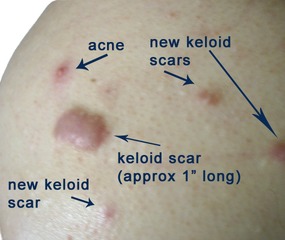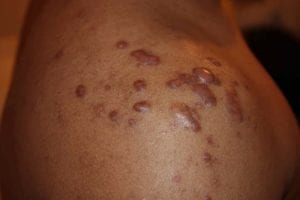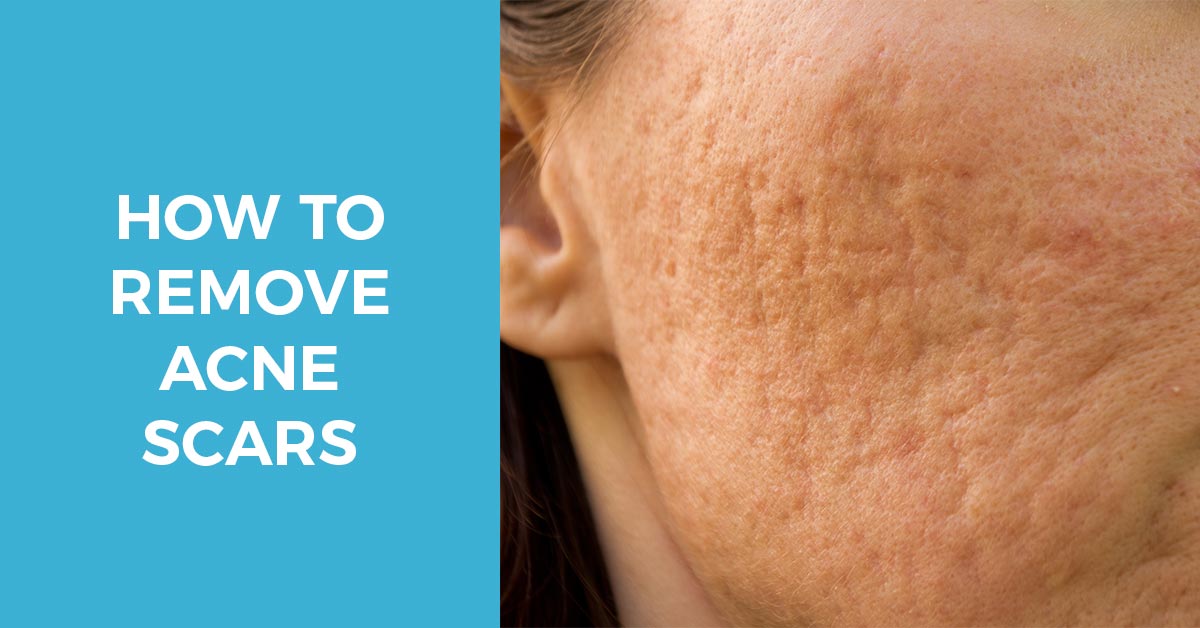Contents
If you’ve ever suffered from spots you’ll know how relieved you are when they start to disappear. But, for many of us, the success of getting rid of those pesky pimples doesn’t last long, because you soon face another problem – how to remove acne scars.
Acne scars or dark marks provide you with a bitter reminder of the stress and trauma you went through when you had acne. They can form in lumps or indents, or may appear on the surface of your skin as pigmented marks. They can cause just as much stress, if not more, as your spots did when you had them.
So, how to get rid of acne scars quickly and effectively?
Thankfully, there is a wide range of treatments available. And to help you tackle your bumps and marks, just as you so successfully did with your acne, we’ll share some helpful tips and advice on how you can remove acne scars before and after they occur.
Understanding the Difference Between Acne Scars and Acne Marks
If you’ve got post-inflammatory hyperpigmentation, this will display itself as brown or red marks that tend to disappear if you stretch your skin out. These will often go away on their own after around 3-24 months but the process can be sped up by using sunscreen, vitamin C serums, topical retinoids, and other over-the-counter brighteners.
However, acne scars create permanent indentations in your skin due to the damage caused to your collagen (a protein in the skin). Due to the severity of these scars, temporary dermal fillers and laser treatments are often the only way you can treat these scars.
These scars come in a whole host of different shapes and sizes, including hypertrophic scars that are raised and thick and stick out above your skin. Or, if the scar has occurred as a result of over-produced skin tissue, this is known as a keloid scar, which is pictured below:

Keloid Acne Scar
Finally, some of the most challenging scars are known as atrophic scars. These show up on your skin as depressions and will fall into one of three categories:
- Rolling Scars – These have sloping, round edges and are broad in shape.
- Boxcar Scars – These have more defined, steep edges and are broad and rectangular in shape.
- Ice Pick Scars – These have jagged edges and are deeper than they are wide. Sometimes, they might appear to look like a pore that’s been scooped out.
Sometimes, if there’s a broken blood vessel that remains after the spot fades away, you may find there’s a purple or red mark instead of a brown one. This is most common in people who are light or fair skinned.
Due to how difficult it is to tell what type of scarring, if any, you may suffer from, it’s best to avoid it entirely by embarking on a great skin care routine and avoiding touching, poking, or picking at pimples.
Nevertheless, there are times when a permanent mark is left by a particularly nasty blemish. These acne scars tend to occur when a fibrous tissue replaces the normal tissue of your skin after it’s been destroyed by the breakout.  For example, you may find it easier to think of this as a wound. Therefore, when the damage caused to your skin is severe, the body may respond (like it does to other injuries) by creating too little or too much tissue.
For example, you may find it easier to think of this as a wound. Therefore, when the damage caused to your skin is severe, the body may respond (like it does to other injuries) by creating too little or too much tissue.
If it produces too much tissue, a hypertrophic or keloid scar may be found. Too little and an atrophic scar or depression of your skin may be caused. The more inflamed or deep your acne lesion is (or the more it’s squeezed and picked), the more likely it is that you’ll get a scar.
Some acne scars and marks are controllable while others cannot be avoided. If you have a deeper skin tone, you may develop hyperpigmentation or darker marks, while redness may become noticeable on lighter skin tones.
Preventing Acne Scars and Dark Marks from Getting Worse
Melanocytes (the cells of your skin that are responsible for producing pigments) can also be supercharged by sun exposure, which may cause your acne scars and/or marks to darken.
The diet you have may also be a contributing factor as certain foods are thought to make acne worse, which increases your chances of developing acne scars or marks. Foods that boost your acne include sugary ones, like starchy foods (white rice, pasta, and bread) and sweets. It’s also worth removing polyunsaturated fats from your diet, too, including soya oil, sunflower oil, and vegetable oil, because these can add to the inflammation of your skin.
Instead, try to eat plenty of vegetables as these work wonders for your skin. Make sure you get a good portion of some fats (the goods ones!) and protein. Coconut oil, nuts, avocados, and olive oil are all good for your skin.
Using Sunscreen to Remove Acne Dark Marks
You needn’t worry about sunscreen clogging your pores up either because there are a number of great formulas available that are acne-friendly. Look for labels that say noncomedogenic because this suggests the product has been specially formulated to not cause blocked pores. Examples of great brands include, Bioderma, Aveda, and La Roche-Posay.
Using a Topical Vitamin C Serum to Remove Acne Dark Marks
Using Retinoids to Remove Acne Dark Marks
Using Chemical Peels to Remove Acne Dark Marks
There are chemical peels available that you can use in your own home, but for stronger treatments you might like to seek the advice of your dermatologist.
Using Skin Lighteners to Remove Acne Dark Marks
Skin lightening ingredients, such as licorice, kojic acid, hydroquinone, vitamin C, and retinol, are beneficial if the marks you have are a browny color. Products that contain these types of ingredients help reverse hyperpigmentation while also preventing this from occurring in the future.
Skin lighteners don’t always work as well on red or pink acne marks that aren’t related to your skin’s melanin or pigment. Instead, these should be treated with the above sunscreen methods, or they can be lightened quite significantly using a pulsed-dye laser. This targets the red pigment of your skin (hemoglobin), and you may find it takes three treatments for the blemishes to disappear completely but you should notice a difference straight after your first treatment.
If, after several months, you aren’t noticing any improvements from the above methods, you might like to look at laser treatments or stronger topical prescriptions which can be recommended by your doctor or dermatologist.
How to Get Rid of Acne Scars
Due to the fact acne scar removal involves more powerful treatments than the above, the special care and attention your dermatologist or doctor can provide you with are recommended for these treatments.
These include:
• How to Get Rid of Acne Scars Using Dermal Fillers
There are a number of scars that can be filled with substances like hyaluronic acid to elevate a depressed area. This can get rid of any shadows created by the scar while also making your skin’s surface look more even.
Dermal fillers didn’t always offer a long-term solution, but now the FDA has approved a dermal filler (Bellafill) that is designed to permanently correct moderate to severe acne scars. It’s different to its counterparts because it contains two different ingredients that help improve the appearance of acne scars.
20% of the filler is polymethylmethacrylate (PMMA), which helps improve the healing process of your body by encouraging it to make more protein. The PMMA acts like a scaffolding network, and because it can be absorbed into your body it won’t degrade over time, providing you with a permanent result. The other 80% is collagen, which is a natural protein in your skin that can become damaged when you suffer from acne.
Overall, this procedure takes around half an hour to complete, and many only require one treatment to see permanent results. Some patients do require a little touch up after a few months.
• How to Get Rid of Acne Scars Using Lasers
Lasers can be beneficial when reducing the redness that often comes with acne scars and marks. When lasers are used, the results will depend on two things – how many treatments you have undergone and how much time you’re willing to devote to your recovery period (you might not feel comfortable socializing straight after the procedure due to the initial side-effects of the laser).

Laser Acne Scar Removal
There are two forms of laser treatment that can be used for mild to moderate acne scars:
- Ablative Laser Treatment – Here, lasers are used to create a smoother area of skin by removing the skin around your acne scar.
- Non-ablative Laser Treatment – The lasers are used to stimulate new collagen to grow, which helps improve the appearance of your skin while also repairing some of the damage caused by your acne.
⇨ How to Get Rid of Acne Scars Using Punch Techniques
Punch techniques can be used to treat boxcar and ice pick scars. There are three types of punch excisions available:
- Punch Excision – This is primarily used to treat ice pick scars that are deemed “mild”. In this technique, the scar is removed during surgery before the wound is sealed. Once this area has healed, it leaves a more even, smoother patch of skin.
- Punch Elevation – A treatment for boxcar scars, this involves removing the base of the scar through surgery without touching the sides of the scar. The base of the scar is then lifted up so it’s level with the rest of your skin, making sure the scar’s not as noticeable.
- Punch Grafting – If you’ve got deep ice pick scars, this treatment may be recommended. It involves removing the scar, like you do in a punch excision, but the wound is “plugged” with skin that’s taken from another area of your body (often from behind the ear). This helps reduce the appearance of this severe scar, giving your skin an even appearance.
⇨ How to Get Rid of Acne Scars Using Steroid Injections
These shots can be administered by your dermatologist on the same day you feel a stress pimple is developing. This immediately reduces the risk of inflammation but the cortisone also helps to create a softer, flatter appearance for thick scars. However, as these injections are designed for raised scars they may flatten out the scar but they won’t eliminate the texture of it.
⇨ How to Get Rid of Acne Scars Using Dermabrasion
Dermabrasion removes the top layer of your skin with a specialist wire brush or lasers. After the treatment your skin will be sore and red for a few months but as it starts to heal you should notice that the appearance of your scars are noticeably improved.
⇨ How to Get Rid of Acne Scars Using Subcision
This is another surgical treatment that’s best used on rolling scars. During this procedure, the upper layer of your skin is removed from the scar tissue, which creates a pool of blood in this area. As the blood clots it helps to create connective tissue, which pushes the rolling scar up so it becomes level with your skin’s surface.
After this procedure other treatments can be used to provide further improvements to the appearance of your scars – including laser treatments.
Questions to Ask Before Any Acne Scar Removal Procedure
Here are a few things WebMD.com suggest you might want to ask:
- Will I experience any pain during/after the procedure?
- Will I need any follow-up treatments?
- Are there any risks involved?
- How long will it be before I notice any changes to my scars?
- Will I need more than one treatment?
- What am I allowed to (or not allowed to) do after the surgery?
- How much is this treatment program going to cost?
- Will this treatment be covered by my insurance? If so, what aspects am I insured for?
Have you suffered from dark marks or acne scars in the past? We’d love to hear your thoughts on the best ways of how to remove acne scars. Please share your comments and stories in the box below!



